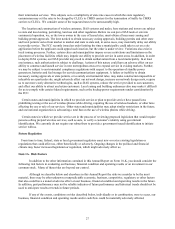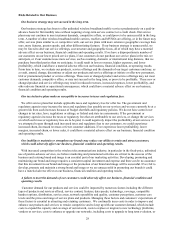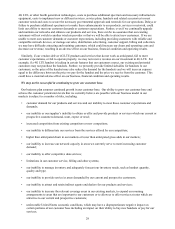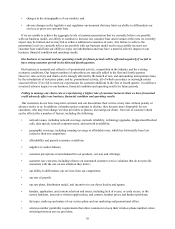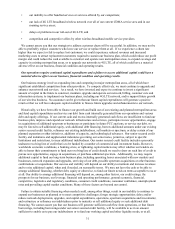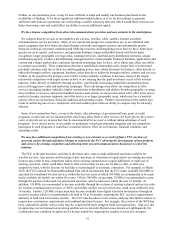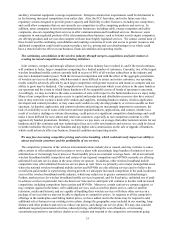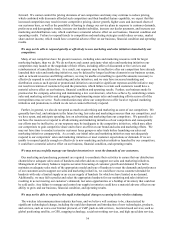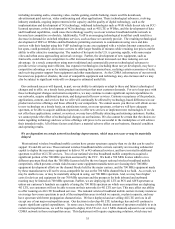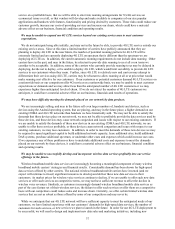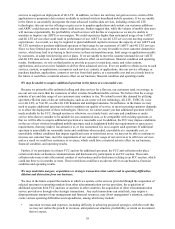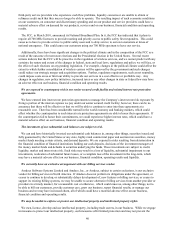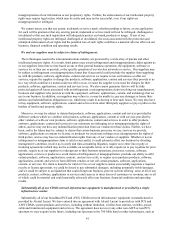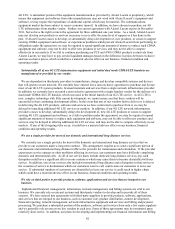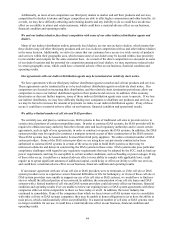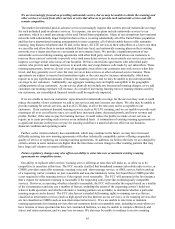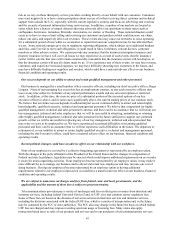Metro PCS 2010 Annual Report Download - page 47
Download and view the complete annual report
Please find page 47 of the 2010 Metro PCS annual report below. You can navigate through the pages in the report by either clicking on the pages listed below, or by using the keyword search tool below to find specific information within the annual report. 37
service on a profitable basis, that we will be able to enter into roaming arrangements for 3G/4G services on
economical terms or at all, or that vendors will develop and make available to companies of our size popular
applications and handsets with features, functionality and pricing desired by customers. These risks could reduce our
customer growth, increase our costs of providing services and increase our churn, which could have a material
adverse effect on our business, financial condition and operating results.
We may be unable to expand our 4G LTE services beyond our existing service area to meet customer
expectations.
We do not anticipate being able initially, and may not in the future be able, to provide 4G LTE service outside our
existing service areas. Since at this time a limited number of carriers have publicly announced that they are
planning to deploy 4G LTE in the near future, the number of potential roaming partners for 4G LTE will be
extremely limited and are currently deploying 4G LTE on spectrum that is different than the spectrum we are
deploying 4G LTE on. In addition, the current automatic roaming requirements do not include data roaming. Other
carriers have in the past, and may in the future, be reluctant to provide data roaming to us at all or on terms we
consider to be acceptable. In addition, some of the carriers who currently provide roaming to us may be delayed in
deploying, decide not to deploy, or be unable to deploy 4G LTE, which would limit our ability to provide 4G LTE
services to our customers when they roam. Further, since 4G LTE is relatively new and carriers may attempt to
differentiate their services using 4G LTE, carriers may be reluctant to allow roaming at all or at prices that would
make roaming cost effective for our customers. If our customers or potential customers demand 4G LTE services on
a nationwide basis or our competitors offer 4G services on a nationwide basis, we may be unable to meet customer
expectations or demands and we may attract less than the anticipated number of 4G LTE customers or we may
experience higher than anticipated levels of churn. If we do not attract the number of 4G LTE customers we
anticipate, it could have a material adverse effect on our business, financials and results of operations.
We may have difficulty meeting the demands placed on our network by data products.
We are increasingly selling, and may in the future sell even larger numbers of, handsets and devices, such as
devices using the Android operating system, that are placing, and may in the future place, a higher demand on our
existing CDMA and 4G LTE networks than handsets we have historically sold. We may not be able to satisfy the
demands that these devices place on our network, we may not be able to profitably provide the data services used by
these devices, and these devices may cause network congestion and issues with respect to our existing customers. If
we are unable to satisfy the demands of these new devices in our existing CDMA and 4G LTE networks, we are
unable to offer these services profitably, or these devices cause network congestion and issues with respect to our
existing customers, we may lose customers. In addition, in order to meet the demands of these new devices we may
be required to spend significant capital to build additional network capacity, lease additional sites, build additional
DAS systems, purchase additional spectrum, or undertake other costs and expenses which could increase our costs.
If we experience any of these problems or have to undertake additional costs and expenses to meet the demands
placed on our network by these devices, it could have a material adverse effect on our business, financial condition
and operating results.
We may be unable to successfully develop and incorporate wireless data services profitably into our service
offerings in the future.
Wireless broadband mobile data services are increasingly becoming a meaningful component of many wireless
broadband mobile carriers’ strategies and financial results. Considerable demand has been shown for high-speed
data services offered by other carriers. The national wireless broadband mobile carriers have invested (and we
expect will continue to invest) significant resources to develop and deliver these new data services to their
customers. As market prices for wireless voice services continue to decline, if we are unable to offer such new data
services or offer such services on competitive terms, we may not have sufficient revenue to offset the decline in
wireless voice revenues. Similarly, as customers increasingly demand wireless broadband mobile data services as
part of the core feature set of their wireless services, the failure to offer such services or offer them on a competitive
basis with our competitors could reduce sales and increase churn. Currently, we offer certain limited wireless data
services that are not as robust as those offered by some of our competitors and may never be.
While we anticipate that our 4G LTE network will have sufficient capacity to meet the anticipated needs of our
customers, we have limited experience with our customers’ demands for high-speed data services, the number of
customers for such services, or new services we plan to launch in the future. In order for our 4G LTE deployment to
be successful, we will need to design and implement new data sales and marketing initiatives, including new


